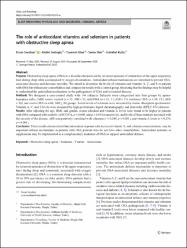The role of antioxidant vitamins and selenium in patients with obstructive sleep apnea
Özet
Purpose Obstructive sleep apnea (OSA) is a disorder characterized by recurrent episodes of obstruction of the upper respiratory tract during sleep often accompanied by oxygen desaturations. Antioxidant defense mechanisms are important to prevent OSA-associated diseases and decrease mortality. We aimed to determine the levels of selenium and vitamins A, C, and E in patients with OSA but without any comorbidities and compare the results with a control group, theorizing that the findings may be helpful to understand the antioxidant mechanisms in the pathogenesis of OSA and associated diseases. Methods We designed a case-control study with 146 subjects. Subjects were categorized into four groups by apnea-hypopnea index (AHI) scores: control (n = 32; AHI < 5), mild OSA (n = 32; 5 <= AHI < 15), moderate OSA (n = 34; 15 <= AHI < 30), and severe OSA (n = 48; AHI >= 30) groups. Serum levels of selenium were measured by atomic absorption spectrometer. Vitamin A, C, and E levels were measured by high-performance liquid chromatography and ultraviolet (HPLC-UV) detector. Results After adjusting for age, BMI, and gender, serum selenium and vitamin A levels were found to be higher in patients with OSA compared with controls (ANCOVA,p < 0.008, andp = 0.014 respectively), and levels of these markers increased with the severity of the disease. AHI was positively correlated with selenium (r = 0.289; p < 0.001), and vitamin A levels (r = 0.276; p < 0.001). Conclusion These results demonstrated that antioxidant response with increased vitamin A, and selenium concentrations, may be important defense mechanisms in patients with OSA patients who do not have other comorbidities. Antioxidant nutrients or supplements may be implemented as a complementary treatment of OSA to support antioxidant defense.


















